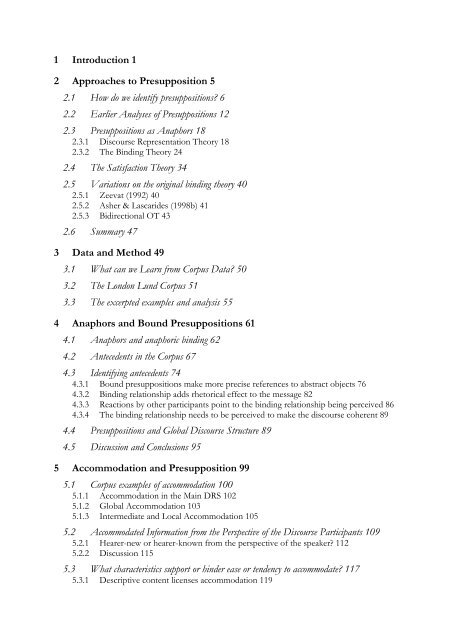Presuppositions in Spoken Discourse
Presuppositions in Spoken Discourse
Presuppositions in Spoken Discourse
Create successful ePaper yourself
Turn your PDF publications into a flip-book with our unique Google optimized e-Paper software.
1 Introduction 1<br />
2 Approaches to Presupposition 5<br />
2.1 How do we identify presuppositions? 6<br />
2.2 Earlier Analyses of <strong>Presuppositions</strong> 12<br />
2.3 <strong>Presuppositions</strong> as Anaphors 18<br />
2.3.1 <strong>Discourse</strong> Representation Theory 18<br />
2.3.2 The B<strong>in</strong>d<strong>in</strong>g Theory 24<br />
2.4 The Satisfaction Theory 34<br />
2.5 Variations on the orig<strong>in</strong>al b<strong>in</strong>d<strong>in</strong>g theory 40<br />
2.5.1 Zeevat (1992) 40<br />
2.5.2 Asher & Lascarides (1998b) 41<br />
2.5.3 Bidirectional OT 43<br />
2.6 Summary 47<br />
3 Data and Method 49<br />
3.1 What can we Learn from Corpus Data? 50<br />
3.2 The London Lund Corpus 51<br />
3.3 The excerpted examples and analysis 55<br />
4 Anaphors and Bound <strong>Presuppositions</strong> 61<br />
4.1 Anaphors and anaphoric b<strong>in</strong>d<strong>in</strong>g 62<br />
4.2 Antecedents <strong>in</strong> the Corpus 67<br />
4.3 Identify<strong>in</strong>g antecedents 74<br />
4.3.1 Bound presuppositions make more precise references to abstract objects 76<br />
4.3.2 B<strong>in</strong>d<strong>in</strong>g relationship adds rhetorical effect to the message 82<br />
4.3.3 Reactions by other participants po<strong>in</strong>t to the b<strong>in</strong>d<strong>in</strong>g relationship be<strong>in</strong>g perceived 86<br />
4.3.4 The b<strong>in</strong>d<strong>in</strong>g relationship needs to be perceived to make the discourse coherent 89<br />
4.4 <strong>Presuppositions</strong> and Global <strong>Discourse</strong> Structure 89<br />
4.5 Discussion and Conclusions 95<br />
5 Accommodation and Presupposition 99<br />
5.1 Corpus examples of accommodation 100<br />
5.1.1 Accommodation <strong>in</strong> the Ma<strong>in</strong> DRS 102<br />
5.1.2 Global Accommodation 103<br />
5.1.3 Intermediate and Local Accommodation 105<br />
5.2 Accommodated Information from the Perspective of the <strong>Discourse</strong> Participants 109<br />
5.2.1 Hearer-new or hearer-known from the perspective of the speaker? 112<br />
5.2.2 Discussion 115<br />
5.3 What characteristics support or h<strong>in</strong>der ease or tendency to accommodate? 117<br />
5.3.1 Descriptive content licenses accommodation 119











